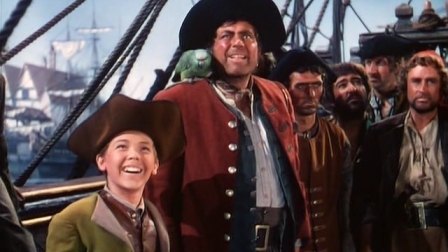I promised myself, as I slogged through the last few segments on Seduction of the Innocent, that I would allow myself to write about something I really enjoyed. “Maybe a piece on live-action Disney movies or something,” I thought. And then, I thought, “Why not?” After all, there’s quite a lot of live action Disney to write about, much of it obscure or relatively so. I have no intention of writing about every live action Disney movie; for one thing, the small amount I make on Patreon does not count as getting paid enough to see The Gnome-Mobile ever again.
But, sure, a look at a lot of them? Why not? Maybe not the stuff everyone covers, but the stuff I saw over and over and over again on the lost and lamented Disney Channel of my childhood? There are things to be said there, including how they tie in with the culture of their time and how they influenced later movies. So sure, here we are.
And where better to start than with Treasure Island, the 1950 work that was the first fully live-action film from Walt Disney Productions? If you’re going to talk about Disney, why not start from the beginning? The only other place that seems a sensible beginning is the Alice shorts, and I kind of don’t have the patience for those.
So. Treasure Island. There had been five previous versions, including a short and a Soviet version that apparently has very little to do with the original Robert Louis Stevenson book. This was, however, the first version in colour. It featured young Bobby Driscoll as Jim Hawkins, working at the country inn owned by his mother, Not Appearing in This Film. He is rapidly drawn off to sea in a whirl of adventure mostly dealing with Long John Silver, here Robert Newton.
Despite being a mostly forgotten film, it has had a larger impact on cultural history than people realize. Robert Newton was born in Shaftesbury, Dorset; while his native accent wasn’t quite that thick, his is indeed the accent people think of when they “talk like a pirate.” It probably helped that he also played Blackbeard once. So yeah, when you’re talking like a pirate, it’s a tribute to the Disney Treasure Island.
It’s also worth noting that, when Disney did an animated version fifty-two years later, they not only restored the character of Jim’s mother, they made another character female. This version has no female characters whatsoever. I assume they left out Jim’s mother because she just slows down the beginning of the plot, and of course there are no women later in the story, because where in the story would they fit? It’s period appropriate, but still. There are a lot more examples of movies where it’s completely appropriate to have no female characters than ones where it’s completely appropriate to have no male ones.
I’m not entirely sure why Disney decided that the place to start their live action division was with a rousing action-adventure flick, but sure, that was a choice. And director Byron Haskin was kind of an odd choice, too. He doesn’t seem to have worked with Disney before. He wasn’t known for swashbucklers; he was barely known at all, it seems, and isn’t much better known now. (He did make the 1953 War of the Worlds and a few other minor sci-fi classics, and he did special effects for a few dozen movies, but he’s hardly a household name.) Still, from a technical perspective, it worked out nicely.
The acting . . . we’re going to have a lot to say about the acting in these movies, and I’ll admit that Bobby Driscoll is not a great place to start. He’s mostly mugging for the camera, and goodness knows he’s not alone in that; this is a poorly acted film all the way around, to be honest. He would do considerably better as a voice actor in Peter Pan, and it’s heartrending to discover that his contract was probably terminated early due to severe acne—and that he died young and was buried in an unmarked grave in a New York paupers’ cemetery. But there is, after all, a certain amount of mugging expected from child actors from this era. That’s what they were required to do.
All in all, Treasure Island is fairly mid-range Disney. Neither all that good nor really all that bad, the main reason it’s memorable at all is its place as First. Disney had dabbled with live action before, but it was always interspersed with live action; the way Disney did that was revolutionary. But I think this was, as much as anything, Walt proving that he didn’t need animation to make a successful movie. Which obviously, he did not. We’ll even get to some genuinely good ones later.

